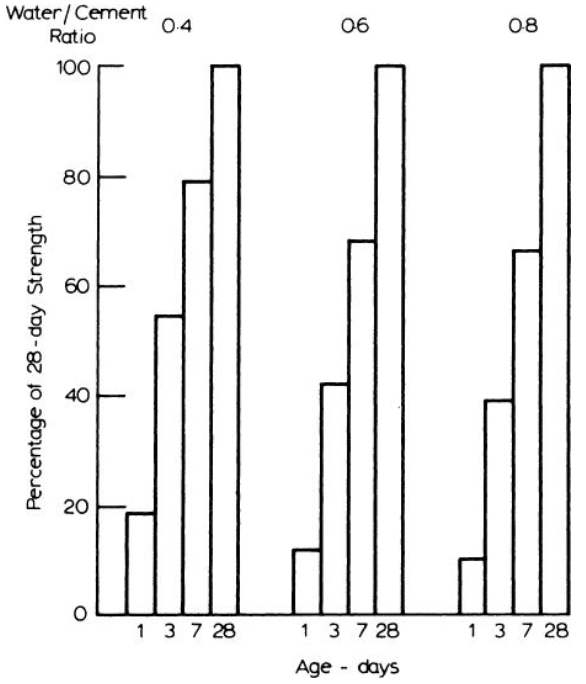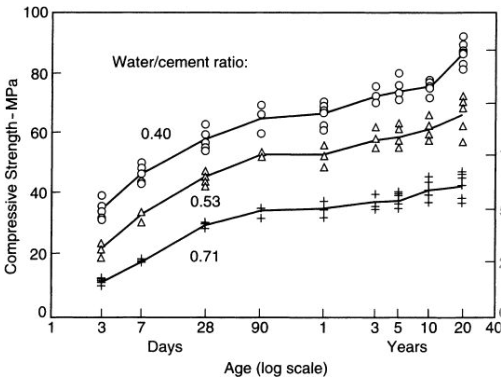Effect of Age on Concrete Strength
The strength versus gel/space ratio relationship has a general application because the amount of gel present in the cement paste at any time is itself a function of age and type of cement. The latter relation thus allows for the fact that different cements require a different length of time to produce the same quantity of gel.
In concrete practice, the strength of concrete is traditionally characterized by the 28-day value, and some other properties of concrete are often referred to the 28-day strength. There is no scientific significance in the choice of the age of 28 days; it is simply that early cements gained strength slowly and it was necessary to base the strength description on concrete in which a significant hydration of cement had already taken place. The specific choice of a multiple of weeks was, in all likelihood, made so that testing, like placing, would fall on a working day. In modern Portland cements, the rate of hydration is much greater than in the past, both because they have a much higher fineness and because they have a higher C3S content. This is, however, not necessarily the case with all blended cements. It is arguable that a shorter period than 28 days could be used for the characterization of strength, but the age of 28 days seems to have acquired an immutable position. Thus, compliance with the specification is almost invariably laid down in terms of the 28-day strength. If, for some reason, the 28-day strength is to be estimated from the strength determined at an earlier age, say 7 days, then the relation between the 28-day and the 7-day strengths has to be established experimentally for the given mix. For this reason, the various expressions for the ratio of the two strengths are no longer thought to be reliable.
Not only the properties of cement but the water/cement ratio also affect the rate of gain of strength of concrete. Mixes with a low water/ cement ratio gain strength, expressed as a percentage of long-term strength, more rapidly than mixes with higher water/cement ratios (Figure 1). This is because in the former case the cement grains are closer to one another and a continuous system of gel is established more rapidly. It should be noted that in a hot climate the early strength gain is high and the ratio of the 28-day to 7-day strengths tends to be lower than in cooler weather. This is also the case with some lightweight aggregate concretes.

Knowledge of the strength–time relation is of importance when a structure is to be put into use, that is, subjected to full loading, at a later age: in such a case, the gain in the strength after the age of 28 days can be taken into account in design. In some other situations, for example in precast or in prestressed concrete, or when early removal of formwork is required, the strength at an early age needs to be known. Data on the development of strength of concretes made with water/cement ratios of 0.40, 0.53, and 0.71 are shown in Figure 2 for concretes made with Type I cement in 1948 are continuously kept wet.

As far as the really long-term strength is concerned, American Portland cements made at the beginning of the century (which had a high C2S content and a low specific surface) led to an increase in the strength of concrete stored outdoors which was proportional to the logarithm of age up to 50 years. The 50-year strength was typically 2.4 times the 28-day strength. However, cements made since the 1930s (with a lower C2S content and a higher specific surface) reach their peak strength between 10 and 25 years, and thereafter undergo some retrogression of strength. German Portland cements made in 1941, when used in concrete stored outdoors, led after 30 years to a strength 2.3 times the 28-day strength. The relative increase in strength was greater at higher water/cement ratios. By comparison, Portland blast furnace cement led to a 3.1-fold increase.
